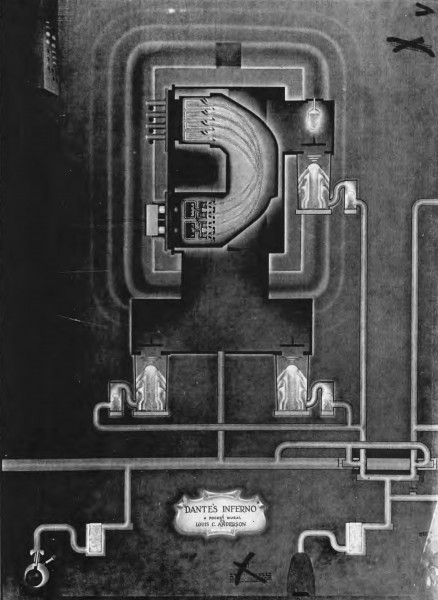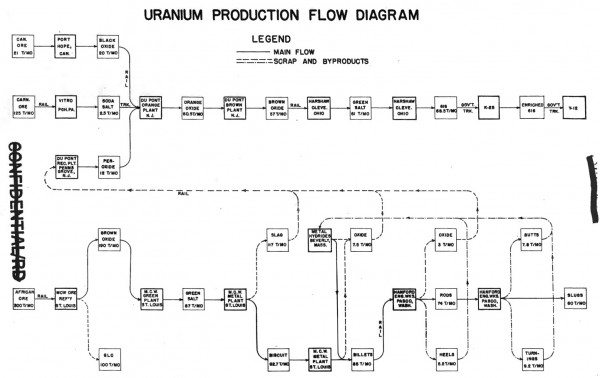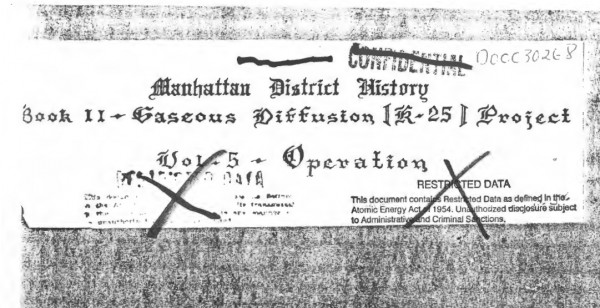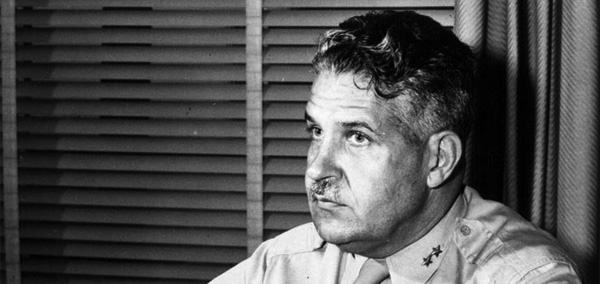The first history of the Manhattan Project that was ever published was the famous Smyth Report, which was made public just three days after the bombing of Nagasaki. But the heavily-redacted Smyth Report understandably left a lot out, even if it did give a good general overview of the work that had been done to make the bomb. Deep within the secret files of the Manhattan Project, though, was another, classified history of the atomic bomb. This was General Leslie Groves’ Manhattan District History. This wasn’t a history that Groves ever intended to publish — it was an internal record-keeping system for someone who knew that over the course of his life, he (and others) would need to be able to occasionally look up information about the decisions made during the making of the atomic bomb, and that wading through the thousands of miscellaneous papers associated with the project wouldn’t cut it.
Groves’ concern with documentation warms this historian’s heart, but it’s worth noting that he wasn’t making this for posterity. Groves repeatedly emphasized both during the project and afterwards that he was afraid of being challenged after the fact. With the great secrecy of the Manhattan Project, and its “black” budget, high priority rating, and its lack of tolerance for any external interference, came a great responsibility. Groves knew that he had made enemies and was doing controversial things. There was a chance, even if everything worked correctly (and help him if it didn’t!), that all of his actions would land him in front of Congress, repeatedly testifying about whether he made bad decisions, abused public trust, and wasted money. And if he was asked, years later, about the work of one part of the project, how would he know how to answer? Better to have a record of decisions put into one place, should he need to look it up later, and before all of the scientists scattered to the wind in the postwar. He might also have been thinking about the memoir he would someday write: his 1962 book, Now it Can Be Told, clearly leans heavily on his secret history in some places.
Groves didn’t write the thing himself, of course. Despite his reputation for micromanagement, he had his limits. Instead, the overall project was managed by an editor, Gavin Hadden, a civil employee for the Army Corps of Engineers. Individual chapters and sections were written by people who had worked in the various divisions in question. Unlike the Smyth Report, the history chapters were not necessarily written near-contemporaneously with the work — most of the work appears to have been started after the war ended, some parts appear to have not been finished until 1948 or so.
In early August 1945 — before the bombs had been dropped — a guide outlining the precise goals and form of the history was finalized. It explained that:
The purpose of the history is to serve as a source of historical information for War Department officials and other authorized individuals. Accordingly, the viewpoint of the writer should be that of General Groves and the reader should be considered as a layman without any specialized knowledge of the subject who may be critical of the Department or the project.
Which is remarkably blunt: write as if Groves himself was saying these things (because someday he might!), and write as if the reader is someone looking for something to criticize. Later the guide gives some specific examples on how to spin problematic things, like the chafing effect of secrecy:
For example, the rigid security restrictions of the project in many cases necessitated the adoption of unusual measures in the attainment of a local objective but the maintenance of security has been recognized throughout as an absolute necessity. Consequently, instead of a statement such as, “This work was impeded by the rigid security regulations of the District,” a statement such as, “The necessity of guarding the security of the project required that operations be carried on in — etc.” would be more accurate.1
This was the history that Groves grabbed whenever he did get hauled in front of Congress in the postwar (which happened less than he had feared, but it still happened). This was the history that the Atomic Energy Commission relied upon whenever it needed to find out what its predecessor agencies had done. It was a useful document to have around, because it contains all manner of statistics, technical details, legal details, and references to other documents in the archive.

“Dante’s Inferno: A Pocket Mural” by Louis C. Anderson, a rather wonderful and odd drawing of the Calutron process. From Manhattan District History, Book 5, “Electromagnetic Project,” Volume 6.
The Manhattan District History became partially available to the general public in 1977, when a partial version of it was made available on microfilm through the National Archives and University Publications of America as Manhattan Project: Official History and Documents. The Center for Research Libraries has a digital version that you can download if you are part of a university that is affiliated with them (though its quality is sometimes unreadable), and I’ve had a digital copy for a long time now as a result.2 The 1977 microfilm version was missing several important volumes, however, including the entire book on the gaseous diffusion project, a volume on the acquisition of uranium ore, and many technical volumes and chapters about the work done at Los Alamos. All of this was listed as “Restricted” in the guide that accompanied the 1977 version.3
I was talking with Bill Burr of the National Security Archive sometime in early 2013 and it occurred to me that it might be possible to file a Freedom of Information Act request for the rest of these volumes, and that this might be something that his archive would want to do. I helped him put together a request for the missing volumes, which he filed. The Department of Energy got back pretty promptly, telling Bill that they were already beginning to declassify these chapters and would eventually put them online.

Manhattan Project uranium production flow diagram, from Manhattan District History, Book 7, “Feed materials.”
The DOE started to release them in chunks in the summer of 2013, and got the last files up this most recent summer. You can download each of the chapters individually on their website, but their file names are such that they won’t automatically sort in a sensible way in your file system, and they are not full-text searchable. The newly-released files have their issues — a healthy dose of redaction (and one wonders how valuable that still is, all these years — and proliferations — later), and some of the images have been run through a processor that has made them extremely muddy to the point of illegibility (lots of JPEG artifacts). But don’t get me started on that. (The number of corrupted PDFs on the NNSA’s FOIA website is pretty ridiculous for an agency that manages nuclear weapons.) Still, it’s much better than the microfilm, if only because it is rapidly accessible.
But you don’t need to do that. I’ve downloaded them all, run them through a OCR program so they are searchable, and gave them sortable filenames. Why? Because I want people — you — to be able to use these (and I do not trust the government to keep this kind of thing online). They’ve still got loads of deletions, especially in the Los Alamos and diffusion sections, and the pro-Groves bent to things is so heavy-handed it’s hilarious at times. And they are not all necessarily accurate, of course. I have found versions of chapters that were heavily marked up by someone who was close to the matter, who thought there were lots of errors. In the volumes I’ve gone the closest over in my own research (e.g. the “Patents” volume), I definitely found some places that I thought they got it a little wrong. But all of this aside, they are incredibly valuable, important volumes nonetheless, and I keep finding all sorts of unexpected gems in them.
You can download all of the 79 PDF files in one big ZIP archive on Archive.org. WARNING: the ZIP file is 760MB or so. You can also download the individual files below, if you don’t want them all at once.

Statistics on the ages of Los Alamos employees, May 1945, from the young spy, Ted Hall (19), to the old master, Niels Bohr (59). From Manhattan District History, Book 8.
What kinds of gems are hidden in these files? Among other things:
- The total number of people who worked on the Manhattan Project — over half a million!
- Impressive flow-charts showing how uranium ore moved throughout the project.
- A crazy drawing of the Calutron process labeled “Dante’s Inferno”!
- Some pretty vivid firsthand accounts of Hiroshima and Nagasaki from the Manhattan Project scientists who visited them.
- Tons of fascinating statistics. Want to know the distribution of ages amongst Los Alamos scientists? We’ve got that — from Ted Hall (age 19) to Niels Bohr (age 59).
- Pretty interesting statistics about the number of fatalities on the project — as you would expect from a project of such size, whose primary employment was construction, a lot of people got injured or died over the course of it, mostly from mundane (non-nuclear) accidents. There’s something comically tragic about working on the project to build the first atomic bomb and getting run over by a tractor.
- A somewhat incredible account of a non-fatal criticality accident early on at Los Alamos: “No ill effects were felt by the men involved, although one lost a little of the hair on his head.”
- Security forms, security guides, security pamphlets — lots of original documents and details that otherwise would have been pretty easily lost in the vastness of the archives. One of my favorites: a declaration of secrecy signed by scientists on the project in which they swear upon the sanctity of their scientific reputation!
And a lot more. As you can see, I’ve drawn on this history before for blog and Twitter posts — I look through it all the time, because it offers such an interesting view into the Manhattan Project, and one that cuts through a lot of our standard narratives about how it worked. There are books and books worth of fodder in here, spread among some tens of thousands of pages. Who knows what might be hidden in there? Let’s shake things up a bit, and find something strange.
Below is the full file listing, with links to my OCR’d copies, hosted on Archive.org. Again, you can download all of them in one big ZIP file by clicking here, (760 MB) or pick them individually from below. Items marked with an asterisk are, as far as know, wholly new — the others have been available on microfilm in one form or another since 1977.
-
- Book I: General
- Volume 1 – General (19.6 MB)
- Volume 1 – General Appendix E; General Index (7.5 MB)
- “Volumes 2 and 3 were not prepared by the Manhattan Engineer District” — This appears to mean that they were not prepared whatsoever — e.g. whatever their contents were were folded into other volumes — but it is unclear.
- Volume 4 – Auxiliary Activities:
- Chapter 1: Legislative Contacts of the Manhattan District (1.6 MB)
- Chapters 2 through Chapter 5 – Foundation of the National Laboratories (Ch. 2); Program for Production and distribution of radioisotopes (Ch. 3); Research and Development of Atomic Energy for Power (Ch. 4); and Declassification and Distribution of Project Information (Ch. 5) (6.4 MB)
- Chapter 6 – Investigation of the After Effects of the Bombing in Japan (5.1 MB)
- Chapter 7 – Contributions of Representatives of the Manhattan District to the Discussions and Proposals for International Control (1 MB)
- Chapter 8 – Press Releases – Part 1 (21.6 MB)
- Chapter 8 – Press Releases – Part 2 (19.2 MB)
- Chapter 9 & 10 – Assistance on the Canadian Pile Project (Ch. 9); and the Oak Ridge Institute of Nuclear Studies (Ch. 10) (2.4 MB)
- Chapter 11 – Ames Project [uranium metal fabrication] (3.1 MB)
- Chapter 12 – Activities of the National Bureau of Standards (1.6 MB)
- Chapter 13 – Preparation and Publication of the Smyth Report (0.9 MB)
- Chapter 14 – Investigation of Miscellaneous Processes of Separation of Uranium Isotopes [centrifuge, isotron, photochemical, others] (124 MB)
- Volume 5 – Fiscal Procedures (5.1 MB)
- Volume 5 – Fiscal Procedures Appendices (7.6 MB)
- Volume 6 – Insurance Program and Supplement (8.2 MB)
- Volume 7 – Medical Program (11.4 MB)
- Volume 7 – Medical Program Supplement (1.2 MB)
- Volume 8 – Personnel (11.8 MB)
- Volume 9 – Priorities Program (3.5 MB)
- Volume 10 – Land Acquisition CEW [Oak Ridge] (3.6 MB)
- Volume 10 – Land Acquisition CEW Appendices (12.1 MB)
- Volume 11 – Safety Program (22.6 MB)
- Volume 11 – Safety Program Appendix G (4.9 MB)
- Volume 12 – Clinton Engineer Works – Central Facilities (13.7 MB)
- Volume 12 – Clinton Engineer Works – Central Facilities Appendices A, B, & C (11.5 MB)
- Volume 12 – Clinton Engineer Works – Central Facilities Appendices D (4.3 MB)
- Volume 13 – Patents (3.5 MB)
- Volume 14 – Intelligence & Security (19.2 MB)
- Volume 14 – Intelligence & Security – Supplement (w/Appendices) (7.1 MB)
- Volume 14 – Intelligence & Security – Foreign Intelligence Supplement No. 1 (6.9 MB)
- Volume 14 – Intelligence & Security – Foreign Intelligence Supplements Nos. 2 & 3 (2.4 MB)
- Volume 14 – Intelligence & Security – Top Secret Appendix to Supplement (1.2 MB)
- Book II: Gaseous Diffusion (K-25) Project
- *Volume 1 – General Features (4.8 MB)
- *Volume 2 – Research (10.2 MB)
- *Volume 3 – Design (25.7 MB)
- *Volume 4 – Construction (26.1 MB)
- *Volume 5 – Operations (18.2 MB)
- *Volume 5 – Operations – Supplement No. 1 (1.5 MB)
- *Volume 5 – Operations – Appendix (2.6 MB)
- Book III: The P-9 Project [heavy water production] (9.1 MB)
- Book IV: Pile Project X-10 [includes Hanford]
- Volume 1 – General Features (2.6 MB)
- Volume 2 – Research Part I – Metallurgical Laboratory (7.1 MB)
- Volume 2 – Research Part II – Clinton Laboratories (8 MB)
- Volume 2 – Research Part II – Clinton Laboratories – Top Secret Appendix (0.2 MB)
- Volume 2 – Research Part II – Clinton Laboratories – Top Secret Appendix (1977 declassified version) (134 KB) [same as the above but you actually can see the data — for whatever reason the DOE didn’t realize, apparently, that the declassified version was already part of the microfilm]
- Volume 3 – Design (6.5 MB)
- Volume 3 – Design Appendices A, B, C, D (5.3 MB)
- Volume 4 – Land Acquisition, HEW [Hanford] (2.7 MB)
- Volume 4 – Land Acquisition, HEW Appendices A, B, C, D, E (7.2 MB)
- Volume 5 – Construction (7.7 MB)
- Volume 5 – Construction – Appendix A (8.5 MB)
- Volume 5 – Construction – Appendices B, C, D, & E (19.1 MB)
- Volume 6 – Operation (6.9 MB)
- Volume 6 – Operations – Appendix A (11 MB)
- Volume 6 – Operations – Appendices B, C, D, E (9.1 MB)
- *Volume 6 – Operations – Top Secret Appendix (2.8 MB)
- Book V: Electromagnetic Project
- Volume 1 – General Features (10.4 MB)
- Volume 2 – Research (12.4 MB)
- Volume 3 – Design (18.8 MB)
- Volume 4 – Silver Program [not a code name — involves accounting for all of the silver borrowed from the Treasury] (12.8 MB)
- Volume 5 – Construction (10.1 MB)
- Volume 6 – Operation (21.1 MB)
- Volume 6 – Operation – Top Secret Appendix (476KB) [this was not included in the DOE release but had been released on microfilm in 1977]
- Book VI: Liquid Thermal Diffusion (S-50) Project – Secret Supplement (0.1 MB)
- Book VII: Feed Materials, Special Procurement, and Geographical Exploration [uranium]
- Book VIII: Los Alamos Project (Y)
- Volume 1 – General (7.7 MB)
- Volume 1 – General Appendices A, B, C, D (6.2 MB)
- Volume 1 – General Appendices E, F (11 MB)
- *Volume 2 – Technical (28.2 MB)
- *Volume 2 – Technical Supplement (19 MB)
- Volume 3 – Auxiliary Activities
- Chapter 1 – Los Angeles Procurement Office (2.9 MB)
- *Chapter 2 – Project Camel [Cal Tech, producing explosive lenses] (10.3 MB)
- *Chapter 3 – Activities of Ohio State University Cryogenic Laboratory (1.3 MB)
- *Chapter 4 – Dayton Project [polonium production] (4.5 MB)
- Chapters 5 and 6 – Navy Participation (Ch. 5) and Sandia (Ch. 6) (0.8 MB)
- Chapter 7 – Boron (4.1 MB)
- Chapter 8 – Operation Crossroads (2.9 MB)
- *Chapter 9 – Supplementary Activities (4.3 MB)
- *History of the Activities of the Manhattan District Research Division (16 MB)
- Book I: General
Small note: there is apparently one missing portion of the History not yet released. This is a Top Secret Supplement to Book I, Volume 4, with the title of “Storage Project.” It seems likely this has something to do with sites where bomb components were stored in the postwar period. It is referenced in the microfilm table of contents and occasionally in the Volume I general index. The DOE has said they do not have a copy of it and so cannot review it for release.
- E.H. Marsden, “Manhattan District History Preparation Guide,” (1 August 1945), copy in the Nuclear Testing Archive, Las Vegas, Nevada, accession number NV0727839. [↩]
- In fact, I used portions of it — gasp! — on actual microfilm very early on my grad school career, when you still had to do that sort of thing. The volume on the patenting program was extremely useful when I wrote on Manhattan Project patent policies. [↩]
- Some of the Los Alamos chapters were later published in redacted form as Project Y: The Los Alamos Story, in 1983. [↩]





Wonderful. I was trying to painfully find my way through the DoE website https://www.osti.gov/opennet/manhattan_district.jsp and here is everything neatly presented. Thanks a lot!
And many thanks again for your blog.
Alex, this is brilliant. Thank you so much for collating all of this and making it available. You could do a Coster-Mullen and bound all of these together and sell them from your store.
I took the liberty of creating a second repository by uploading these to the Internet Archive here: https://archive.org/details/Manhattan_District_History. This should outlive Dropbox. (The source PDFs from DOE are already archived.)
Great — thanks!
Thanks again for this — I converted the Dropbox links to those, and created another page here that links to the big ZIP file.
It seems that your Dropbox account has been locked due to “too much traffic from the public links”, so your links are unfortunately dead at the moment…
Well, that’s annoying. Hopefully they will come back to life soon, or I’ll find another hosting solution. I don’t want to put them on my blog server for obvious reasons.
OK, all of the Dropbox links have been converted to Archive.org links. Let’s see if those stick around a bit longer!
I find the U Processing Flow Chart quite interesting in that it appears as if they were transporting the various processing products back and forth all over the country, mostly by rail. Did they have any kind of special rail cars to do this? Or did they just use ordinary rolling stock so as not to attract attention.
I really don’t know — I suspect they’d have just moved it with regular rolling stock, but that’s a super interesting question, and I’ll poke around a bit. At some point I plan to write something about the uranium flow within the project.
I am relatively confident that the shipments were on regular rolling stock. While I’ve never looked specifically into this question, I’m reasonably knowledgeable about railroad history and not once have I ever come across a reference to the use of special cars.
More to the point, freight rail in the 1940’s was nothing like it is today, with just a handful of merged and consolidated companies dominating the business. Long-distance shipments routinely had to be interchanged among several different companies. It would have been much harder to maintain secrecy of special cars with so many companies being involved.
The Allies tried to control penicillin like they controlled atomic matters, but unlike uranium ores, penicillium mold is self replicating and once one or two sets of spores were out in the medical world, the jig was up.
Ditto with easy photocopying and now even easier digital reproduction : once a few copies of your digital files are out there somewhere unknown to the government, there will be little point in the government ever taking down their files.
Thanks for striking a blow for intellectual freedom !
Oh, my! This is comprehensive, though somewhat redacted. Thank you Alex!
Alex,
Portions of the MDH were published in a book, The Secret History of the Atomic Bomb, edited by Anthony Cave Brown & Charles B. MacDonald ( NY: Dell Publishing Co., 1977). It also includes the Smyth Report and the David Hawkins history of Los Alamos.
Alex,
Congratulations. Brilliant research as usual. For your next miracle, how about finding the deleted Ordnance story from the Smyth Report?
Spent the better part of the previous academic year wading through the volumes on Los Alamos for my thesis…to my knowledge, the published site plan within is the first comprehensive one ever released!!
Many thanks for the OCR’s. Will certainly shave off hours.
Z, can you give us a hint? Such as the page number and volume of the site plan?
Might be referring to the site maps in LosAlamos General Appendices A-D.
In Book VIII, Vol. 1 page 6.63 I found some of the ’cause of deaths’ interesting. 2 from accidental shootings, 2 from self poisoning and 3 from drinking ethylene glycol.
I assume the poison cases were suicides? Maybe the accidental shootings as well? The glycol deaths sound like someone was trying to make cheap booze.
Alex,
In regards to Book I, Volumes 2 & 3 I reread the text of Book I and also Appendix B and DOE just worded it badly. It clearly says that Volumes 2 & 3 are “omitted”. In my experience in the Army, when working on a multi-volume anything that self references you have to decide on volume titles and assignments at some point. So, if work progresses and writers realize that whatever was planned for Volumes 2 & 3 for example, turns out to be redundant or something better incorporated into another text then they’re cancelled and the previous Volume numbers are placeholders.